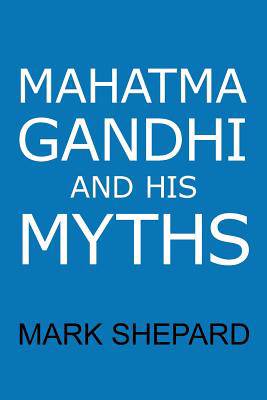
- Retrait gratuit dans votre magasin Club
- 7.000.000 titres dans notre catalogue
- Payer en toute sécurité
- Toujours un magasin près de chez vous
- Retrait gratuit dans votre magasin Club
- 7.000.000 titres dans notre catalogue
- Payer en toute sécurité
- Toujours un magasin près de chez vous
Mahatma Gandhi and His Myths
Civil Disobedience, Nonviolence, and Satyagraha in the Real World (Plus Why It's 'Gandhi, ' Not 'Ghandi')
Mark ShepardDescription
"All my actions have their source in my inalienable love of humankind." -- Gandhi
Mahatma Gandhi is one of the least understood figures of all time -- even among his admirers. In this Annual Gandhi Lecture for the International Association of Gandhian Studies, Mark Shepard tackles some persistently wrong-headed views of Gandhi, offering us a more accurate picture of the man and his nonviolence.
////////////////////////////////////////////////
"A model of Gandhian journalism. . . . [Shepard] has put his finger on seemingly all of the popular (and some less common) misconceptions of both Gandhi and his philosophy, including some particularly important ones. . . . This book takes little space to cover its topic concisely and well. It would be [some] of the most valuable pages many people could read about Gandhi." -- Global Conscience, July-Sept. 1990
////////////////////////////////////////////////
Mark Shepard is the author of "Mahatma Gandhi and His Myths," "The Community of the Ark," and "Gandhi Today," called by the American Library Association's Booklist "a masterpiece of committed reporting." His writings on social alternatives have appeared in over 30 publications in the United States, Canada, England, Norway, Germany, the Netherlands, Switzerland, Japan, and India.
////////////////////////////////////////////////
SAMPLE
I suspect that most of the myths and misconceptions surrounding Gandhi have to do with nonviolence. For instance, it's surprising how many people still have the idea that nonviolent action is passive.
It's important for us to be clear about this: There is nothing passive about Gandhian nonviolent action.
I'm afraid Gandhi himself helped create this confusion by referring to his method at first as "passive resistance," because it was in some ways like techniques bearing that label. But he soon changed his mind and rejected the term.
Gandhi's nonviolent action was not an evasive strategy nor a defensive one. Gandhi was always on the offensive. He believed in confronting his opponents aggressively, in such a way that they could not avoid dealing with him.
But wasn't Gandhi's nonviolent action designed to avoid violence? Yes and no. Gandhi steadfastly avoided violence toward his opponents. He did not avoid violence toward himself or his followers.
Gandhi said that the nonviolent activist, like any soldier, had to be ready to die for the cause. And in fact, during India's struggle for independence, hundreds of Indians were killed by the British.
The difference was that the nonviolent activist, while willing to die, was never willing to kill.
Gandhi pointed out three possible responses to oppression and injustice. One he described as the coward's way: to accept the wrong or run away from it. The second option was to stand and fight by force of arms. Gandhi said this was better than acceptance or running away.
But the third way, he said, was best of all and required the most courage: to stand and fight solely by nonviolent means.
Spécifications
Parties prenantes
- Auteur(s) :
- Editeur:
Contenu
- Nombre de pages :
- 46
- Langue:
- Anglais
Caractéristiques
- EAN:
- 9781620355268
- Date de parution :
- 25-04-17
- Format:
- Livre broché
- Format numérique:
- Trade paperback (VS)
- Dimensions :
- 152 mm x 229 mm
- Poids :
- 81 g







